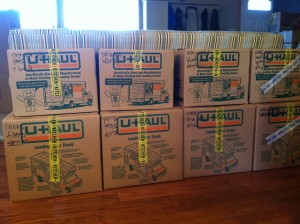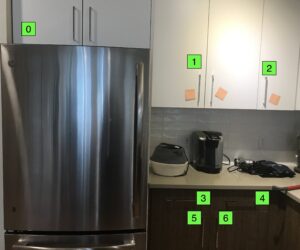 Whether you are hiring movers to pack everything, pack only select items or packing everything yourself, the following tips will help you prep and pack your home like a pro!
Whether you are hiring movers to pack everything, pack only select items or packing everything yourself, the following tips will help you prep and pack your home like a pro!
To Self Pack or Not
If you are using professional movers, anything you self pack is not insurable for damage loss on the truck, unless it is due to poor loading on the mover’s part. If you want your items to be insurable on the truck and are on a budget, you could opt to have movers pack just your breakables and self-pack the non-breakables which are less likely to get damaged in a move.
You can also opt to self-transport your self-packed breakables in your car to lessen chances they will get broken, and if they do, at least it was in your control.
Map and Pack – Fast Pack Tips
 Create a Pack Map: Using super sticky post it notes, or paper and painters tape, number all your cabinet doors and drawers, dresser and desk drawers, etc. Go top to bottom, left to right.
Create a Pack Map: Using super sticky post it notes, or paper and painters tape, number all your cabinet doors and drawers, dresser and desk drawers, etc. Go top to bottom, left to right.- Take pictures of your map in segments from a distance so you can tell area of your home the numbers are referring to.
- Create a folder in your tech and place all the photos in it.
- Before your printer is packed, print the photos and put them aside in your Unpack First Items, or put them in your Self-Transport items for travel in the car.
- As you pack, label each box with the room and door/drawer number.
- When you are unpacking, refer to your Pack Map images for the contents of each box.
Priority / Important Items
- If you need to know which boxes your items of priority and importance get packed in, create custom labels with those item names.
- Tape labels on or near your those items in your home.
- Ask the movers to tape those labels on the boxes they pack those items in.
- In your new home, ask the movers to place those boxes in an area you select with immediate accessibility.
Box It and Fill It
- Anything that fits in a box, goes in a box. It’s much easier and more efficient in space and time to tetris a bunch of similar sized squares and rectangles together than a bunch of awkward shapes and box sizes in the back of a truck.
- Fill the Box – Boxes need to be FULL to prevent the tops from collapsing during stack and transport. Need something to fill in the extra space? Use paper, blankets, towels, plastic, paper and reusable grocery bags, zippered blanket bags, etc. If that something extra is a household item that you will need to know where it is, don’t forget to label that on the box!
No Fold Overs
Refrain from the box top fold and tuck method that requires no tape. While that seems amazing as far as tape usage, it is less amazing when it comes to packing a truck. It can prevent the boxes from sitting flat on top of each other – and that can just turn into a topple nightmare.
Long and Awkward Shapes
Wardrobe boxes are fantastic for tall, long, and awkward shaped items. If you’ve ever looked inside a moving truck, you may have seen your yard tools, tall lamps, ironing board, etc. stashed in an open wardrobe box for transport. This keeps things from rattling around and getting damaged.
Books
Pack your books in small or book boxes only. Refrain from packing them in medium size boxes. While movers are accustomed to loading heavy boxes, a medium box full of books gets to be a bit excessive and they may ask you to repack the books in smaller boxes.
Keep It Contained
If your things are organized into trays and bins inside your drawers and cabinets, the entire bin with contents can be packed as a unit unless of course, there are breakables inside the bin. Movers place the utensil trays, etc. on packing paper and wrap it up as one.
Things to contain and group things together:
- Ziplocs
- Trash bags
- Packing paper
- Twistie ties
- Rubber bands
Looking for tips on something you’re not seeing here? Explore my other journal posts or drop me a line to let me know what you’re looking for!
